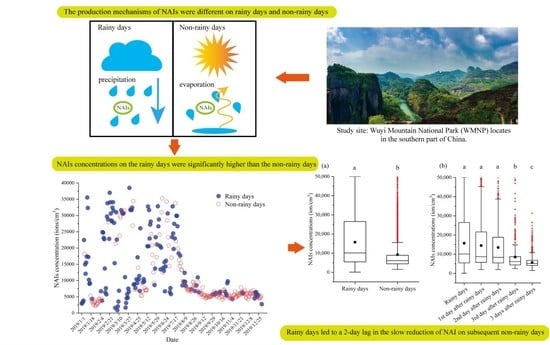The Lagging Effect of Precipitation on NAIs Concentrations on Rainy Days in Wuyi Mountain National Park, China
Abstract
:1. Introduction
2. Methods
2.1. Instrumentation
2.2. Outlier and Invalid Data Detection and Filtering
- (1)
- Invalid data (missing values) due to machine failure and storage failure.
- (2)
- Outliers of 99,999 and 0 in NAIs concentrations due to instrument failure and voltage instability.
- (3)
- Twelve consecutive values with the same data are seen as outliers.
2.3. Division of Rainy and Non-Rainy Days
2.4. Data Analysis
2.5. The Feature Importance Scores of Meteorological Elements in the NAIs Concentrations
2.5.1. Introduction of the Random Forest Model
2.5.2. Data Normalization
2.5.3. Parameter Selection and Feature Importance Scores
2.5.4. RF Model Evaluation
3. Results
3.1. NAIs Concentrations on Rainy and Non-Rainy Days
3.2. Time Series Distribution of NAIs Concentrations on Rainy and Non-Rainy Days
3.3. Correlation Analysis of NAIs Concentrations with Meteorological Factors on Rainy and Non-Rainy Days
3.4. Important Values of Meteorological Factors That Affect NAIs Concentrations on Rainy and Non-Rainy Days
4. Discussion
4.1. NAIs Concentrations on Rainy and Non-Rainy Days
4.2. NAIs Concentrations in Different Types of Non-Rainy Days
4.3. The Effect of Precipitation on Relative Humidity and NAIs
5. Conclusions
Author Contributions
Funding
Institutional Review Board Statement
Informed Consent Statement
Data Availability Statement
Acknowledgments
Conflicts of Interest
References
- Nadali, A.; Arfaeinia, H.; Asadgol, Z.; Fahiminia, M. Indoor and outdoor concentration of PM10, PM2.5 and PM1 in residential building and evaluation of negative air ions (NAIs) in indoor PM removal. Environ. Pollut. Bioavailab. 2020, 32, 47–55. [Google Scholar] [CrossRef]
- Liu, W.; Huang, J.; Lin, Y.; Cai, C.; Zhao, Y.; Teng, Y.; Mo, J.; Xue, L.; Liu, L.; Xu, W.; et al. Negative ions offset cardiorespiratory benefits of PM2.5 reduction from residential use of negative ion air purifiers. Indoor Air. 2021, 31, 220–228. [Google Scholar] [CrossRef]
- Bowers, B.; Flory, R.; Ametepe, J.; Staley, L.; Patrick, A.; Carrington, H. Controlled trial evaluation of exposure duration to negative air ions for the treatment of seasonal affective disorder. Psychiatry Res. 2018, 259, 7–14. [Google Scholar] [CrossRef]
- Liu, R.; Lian, Z.; Lan, L.; Qian, X.; Chen, K.; Hou, K.; Li, X. Effects of negative oxygen ions on sleep quality. Proc. Eng. 2017, 205, 2980–2986. [Google Scholar] [CrossRef]
- Yan, X.; Wang, H.; Hou, Z.; Wang, S.; Zhang, D.; Xu, Q.; Tokola, T. Spatial analysis of the ecological effects of negative air ions in urban vegetated areas: A case study in Maiji, China. Urban For. Urban Green. 2015, 14, 636–645. [Google Scholar] [CrossRef]
- Suwardi, A.; Ooi, C.C.; Daniel, D.; Tan, C.K.I.; Li, H.; Liang, O.Y.Z.; Tang, Y.K.; Chee, J.Y.; Sadovoy, A.; Jiang, S.; et al. The Efficacy of Plant-Based Ionizers in Removing Aerosol for COVID-19 Mitigation. Research 2021, 2021, 2173642. [Google Scholar] [CrossRef]
- Hoppel, W.A.; Anderson, R.V.; Willet, J.C. Atmospheric Electricity in the Planatary Boundary Layer. In The Earth’s Electrical Environment; National Academy Press: Washington, DC, USA, 1986; pp. 195–205. [Google Scholar]
- Borra, J.P.; Roos, R.A.; Renard, D.; Lazar, H.; Goldman, A.; Goldman, M. Electrical and chemical consequences of point discharges in a forest during a mist and a thunderstorm. J. Phys. D Appl. Phys. 1997, 30, 84–93. [Google Scholar] [CrossRef]
- Kosenko, E.A.; Kaminsky, Y.G.; Stavrovskaya, I.G.; Sirota, T.V.; Kondrashova, M.N. The stimulatory effect of negative air ions and hydrogen peroxide on the activity of superoxide dismutase. FEBS Lett. 1997, 410, 309–312. [Google Scholar] [CrossRef]
- Iwama, H. Negative air ions created by water shearing improve erythrocyte deformability and aerobic metabolism. Indoor Air. 2004, 14, 293–297. [Google Scholar] [CrossRef]
- Yamada, R.; Yanoma, S.; Akaike, M.; Tsuburaya, A.; Sugimasa, Y.; Takemiya, S.; Imada, T. Water-generated negative air ions activate NK cell and inhibit carcinogenesis in mice. Cancer Lett. 2006, 239, 190–197. [Google Scholar] [CrossRef]
- Jiang, S.Y.; Ma, A.; Ramachangran, S. Negative air ions and their effects on human health and air quality improvement. Int. J. Mol. Sci. 2018, 19, 2966. [Google Scholar] [CrossRef] [PubMed]
- Zhang, X.; Cao, J.; Zhang, S. Distribution Characteristics of Air Anions in Beidaihe in Different Ecological Environments. J. Geosci. Environ. Prot. 2018, 6, 133–150. [Google Scholar] [CrossRef]
- Vana, M.; Ehn, M.; Petäjä, T.; Vuollekoski, H.; Aalto, P.; Leeuw, G.D.; Ceburnis, D.; O’Dowd, C.D.; Kulmala, M. Characteristic features of air ions at Mace Head on the west coast of Ireland. Atmos. Res. 2008, 90, 278–286. [Google Scholar] [CrossRef]
- Wang, W.; Xia, S.; Zhu, Z.; Wang, T.; Cheng, X. Spatiotemporal distribution of negative air ion and PM2.5 in urban residential areas. Indoor Built Environ. 2022, 31, 1127–1141. [Google Scholar] [CrossRef]
- Ling, D. Review on Research of the Negative Air Ion Concentration Distribution and its Correlation with Meteorological Elements in Mountain Tourist Area. Earth Sci. 2019, 8, 60. [Google Scholar] [CrossRef]
- Lin, S.; Hu, X.; Chen, H.; Wu, C.; Hong, W. Spatio-temporal variation of ecosystem service values adjusted by vegetation cover: A case study of Wuyishan National Park Pilot, China. J. For. Res. 2021, 33, 851–863. [Google Scholar] [CrossRef]
- Xu, X.; Zhou, Y.; Ruan, H.; Luo, Y.; Wang, J. Temperature sensitivity increases with soil organic carbon recalcitrance along an elevational gradient in the Wuyi Mountains, China. Soil Biol. Biochem. 2010, 42, 1811–1815. [Google Scholar] [CrossRef]
- Jizhi, W.; Yuanqin, Y.; Xiaofei, J.; Yang, X.; Guo, D.; Yanzhen, Q.; Xiaoli, G. Influence of meteorological conditions on the negative oxygen ion characteristics of well-known tourist resorts in China. Sci. Total Environ. 2021, 819, 152021. [Google Scholar] [CrossRef]
- Li, C.; Xie, Z.; Chen, B.; Kuang, K.; He, Z. Different time scale distribution of negative air ions concentrations in Mount Wuyi National Park. Int. J. Environ. Res. Public Health 2021, 18, 5037. [Google Scholar] [CrossRef]
- Li, A.; Li, Q.; Zhou, B.; Ge, X.; Cao, Y. Temporal dynamics of negative air ion concentration and its relationship with environmental factors: Results from long-term on-site monitoring. Sci. Total Environ. 2022, 832, 155057. [Google Scholar] [CrossRef]
- Liu, Z.; Liu, Y.; Murphy, J.; Maghirang, R. Estimating Ambient Ozone Effect of Kansas Rangeland Burning with Receptor Modeling and Regression Analysis. Environments 2017, 4, 14. [Google Scholar] [CrossRef]
- Shi, G.; Zhou, Y.; Sang, Y.; Huang, H.; Zhang, J.; Meng, P.; Cai, L. Modeling the response of negative air ions to environmental factors using multiple linear regression and random forest. Ecol. Inform. 2021, 66, 101464. [Google Scholar] [CrossRef]
- Munkhdalai, L.; Munkhdalai, T.; Park, K.H.; Lee, H.G.; Li, M.; Ryu, K.H. Mixture of activation functions with extended min-max normalization for forex market prediction. IEEE Access. 2019, 7, 183680–183691. [Google Scholar] [CrossRef]
- Pedregosa, F.; Varoquaux, G.; Gramfort, A.; Michel, V.; Thirion, B.; Grisel, O.; Blondel, M.; Prettenhofer, P.; Weiss, R.; Dubourg, V.; et al. Scikit-learn: Machine Learning in Python. J. Mach. Learn. Res. 2011, 12, 2825–2830. [Google Scholar]
- Ramayanti, D.; Salama, H.U. Text Classification on Dataset of Marine and Fisheries Sciences Domain using Random Forest Classifier. Int. J. Comput. Tech. 2018, 5, 1–7. [Google Scholar]
- Aslam, S.; Ayub, N.; Farooq, U.; Alvi, M.J.; Albogamy, F.R.; Rukh, G.; Haider, S.I.; Azar, A.T.; Bukhsh, R. Towards Electric Price and Load Forecasting Using CNN-Based Ensembler in Smart Grid. Sustainability 2021, 13, 12653. [Google Scholar] [CrossRef]
- Li, W.; Wu, H.; Duan, S.; Li, Z.; Liu, Q. Selection of Predictor Variables in Downscaling Land Surface Temperature using Random Forest Algorithm. In Proceedings of the IGARSS 2019—2019 IEEE International Geoscience and Remote Sensing Symposium, Yokohama, Japan, 28 July–2 August 2019; pp. 1817–1820. [Google Scholar]
- Su, W. Spatial-temporal Distribution Characteristics of PM2.5 and PM10 in Nanchang City and the Mechanism Blocked by Urban Forest. Ph.D. Dissertation, Jiangxi Agricultural University, Nanchang, China, 2017. [Google Scholar]
- Zhang, C.; Wu, Z.; Li, Z.; Li, H.; Lin, J. Inhibition effect of negative air ions on adsorption between volatile organic compounds and environmental particulate matter. Langmuir 2020, 36, 5078–5083. [Google Scholar] [CrossRef]
- Kalchikhin, V.; Kobzev, A.; Nagorskiy, P.; Oglezneva, M.; Pustovalov, K.; Smirnov, S.; Filatov, D. Connected Variations of Meteorological and Electrical Quantities of Surface Atmosphere under the Influence of Heavy Rain. Atmosphere 2020, 11, 1195. [Google Scholar] [CrossRef]
- Wang, Y.; Ni, Z.; Di, W.; Fan, C.; Lu, J.; Xia, B. Factors influencing the concentration of negative air ions during the year in forests and urban green spaces of the Dapeng Peninsula in Shenzhen, China. J. For. Res. 2019, 31, 2537–2547. [Google Scholar] [CrossRef]
- Grinshpun, S.A.; Mainelis, G.; Trunov, M.; Adhikari, A.; Reponen, T.; Willeke, K. Evaluation of ionic air purifiers for reducing aerosol exposure in confined indoor spaces. Indoor Air. 2005, 15, 235–245. [Google Scholar] [CrossRef]
- Tammet, H.; Komsaare, K.; Hõrrak, U. Intermediate ions in the atmosphere. Atmos. Res. 2014, 135–136, 263–273. [Google Scholar] [CrossRef]
- Miao, S.; Zhang, X.; Han, Y.; Sun, W.; Liu, C.; Yin, S. Random Forest Algorithm for the Relationship between Negative Air Ions and Environmental Factors in an Urban Park. Atmosphere 2018, 9, 463. [Google Scholar] [CrossRef]
- Xu, Z.; Ma, L.; Chen, M.; Bai, J.; Chen, P.; Han, Y.; Lu, X.; Wang, B.; Zhao, D.; Luo, X.; et al. The avian community structure of Wuyi Mountains is sensitive to recent climate warming. Sci. Total Environ. 2021, 776, 145825. [Google Scholar] [CrossRef]
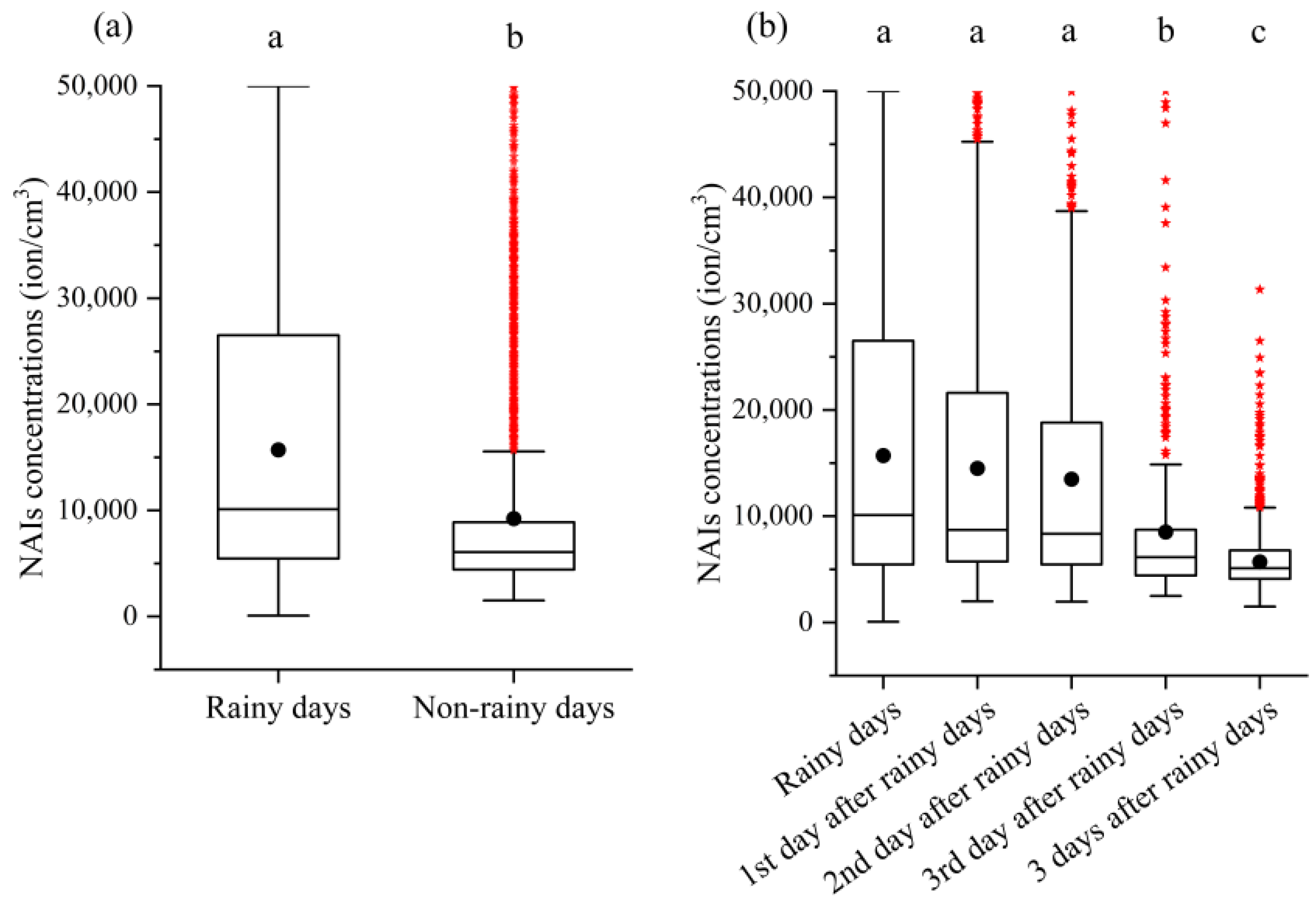
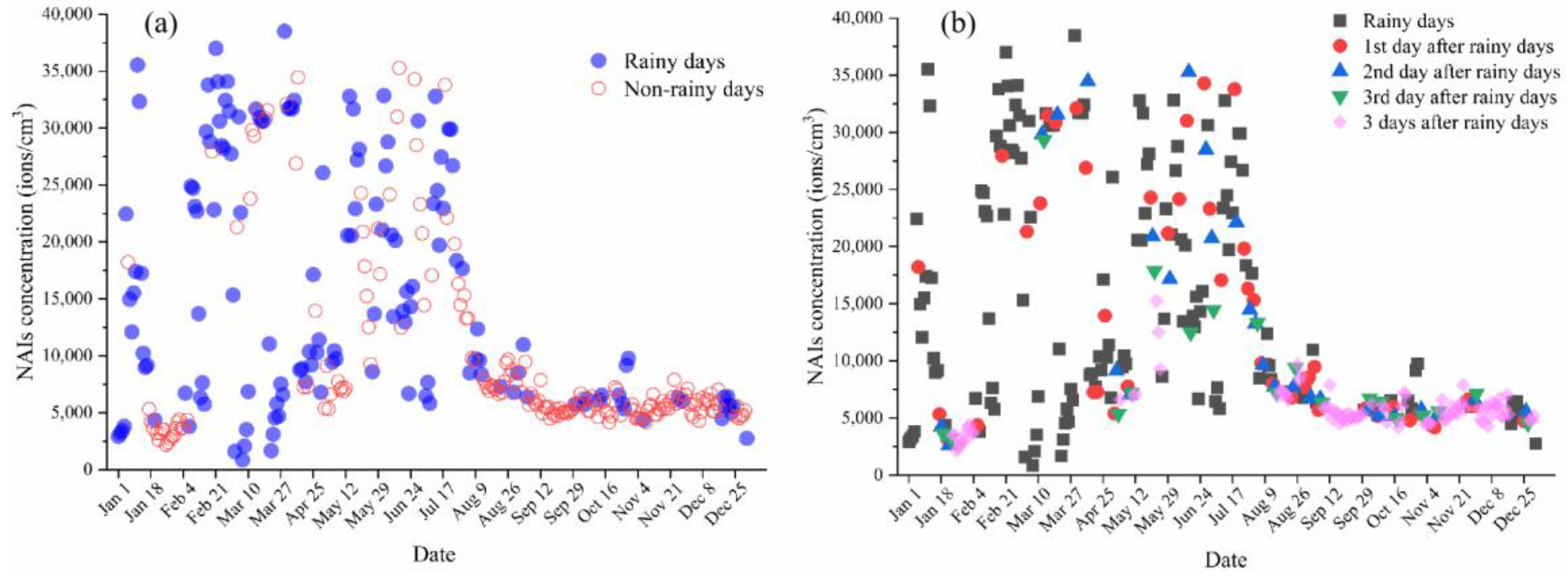
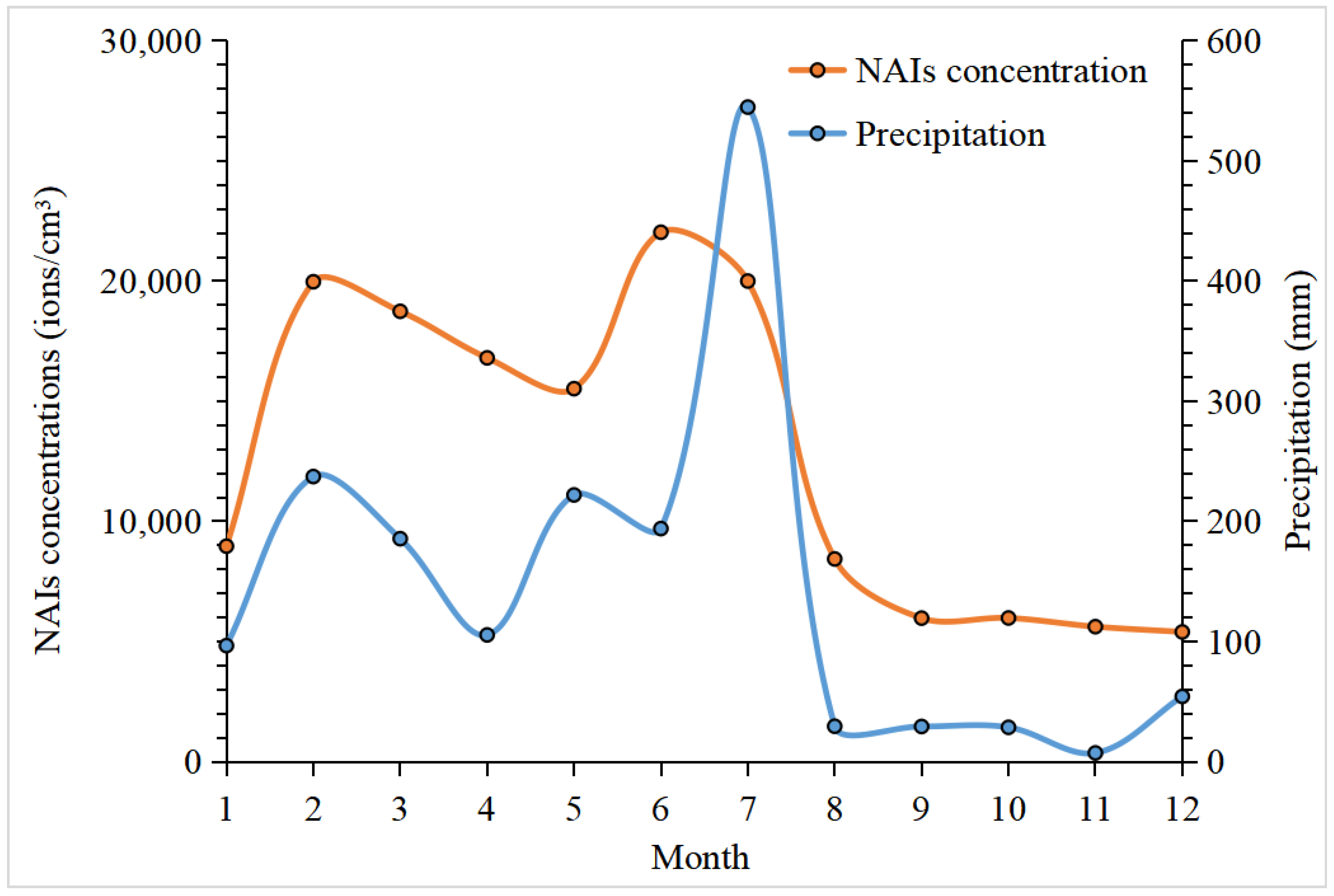
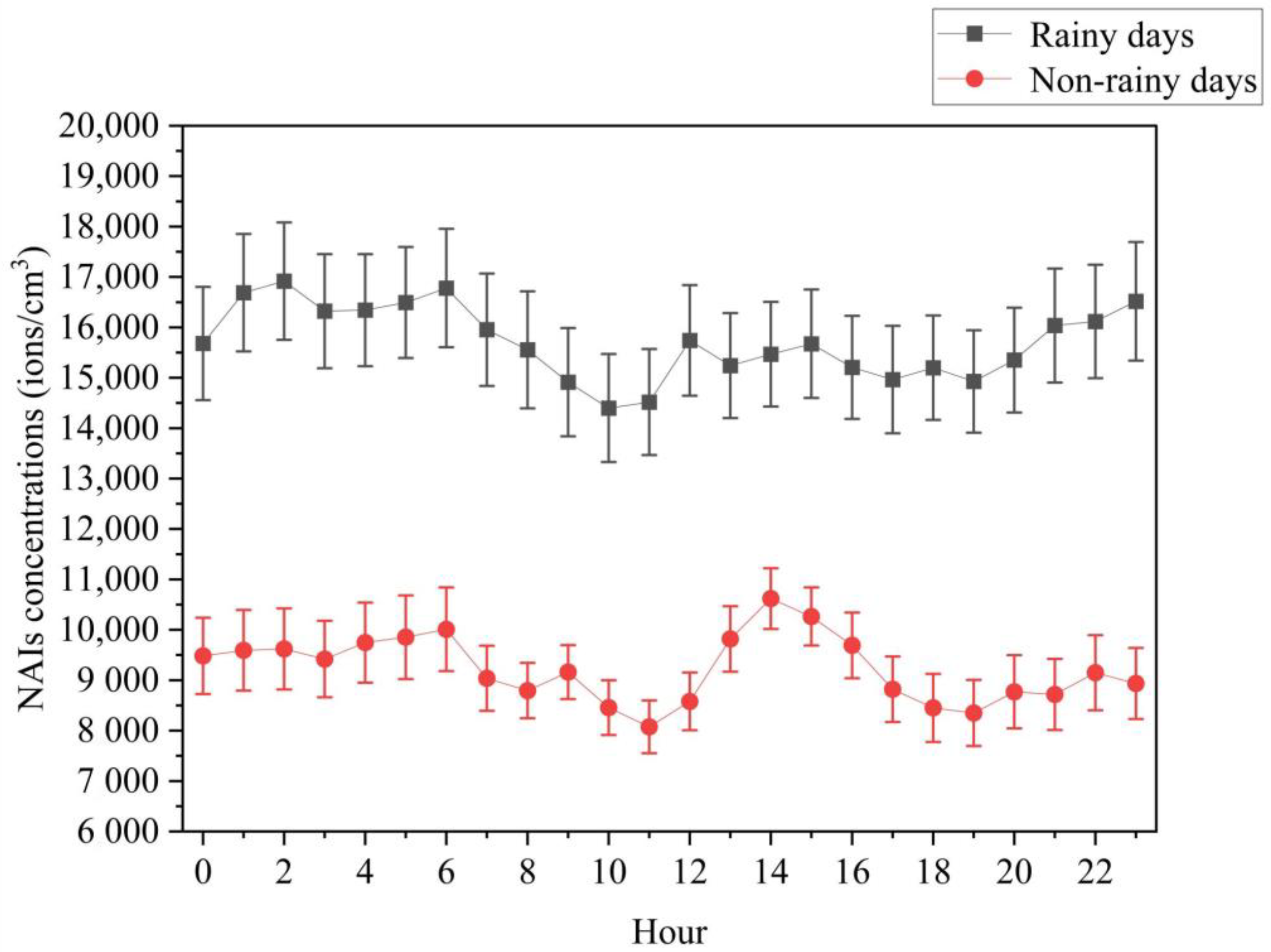
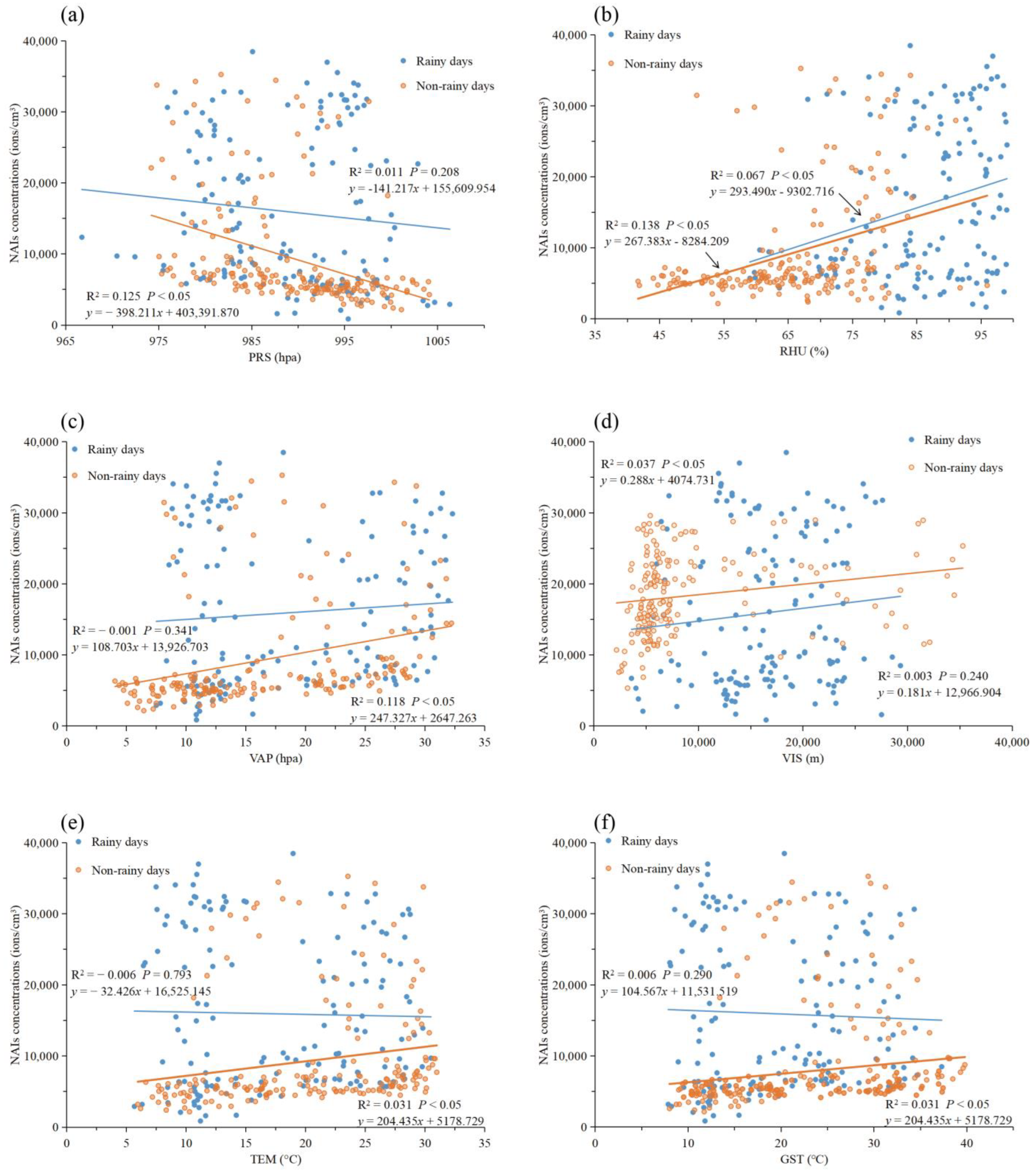
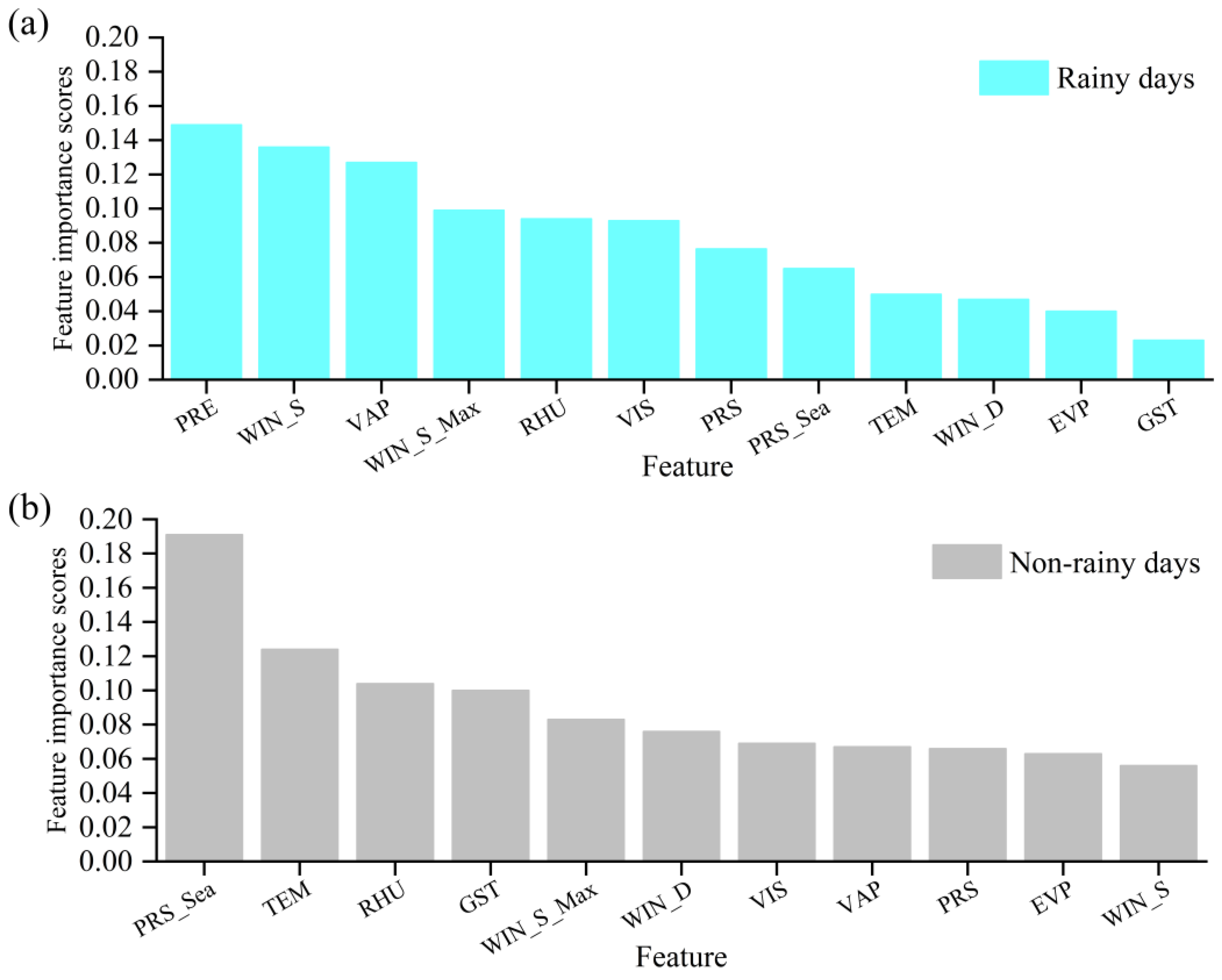
| Type | Median (P25, P75) | Wilcoxon Test | |
|---|---|---|---|
| z Value | p-Value | ||
| Rainy days | 10,109.17 (5464.17, 26,513.50) | 22.171 | <0.05 |
| Non-rainy days | 6067.70 (4416.09, 8894.13) | ||
| Type | Kruskal–Wallis Test | |
|---|---|---|
| z Value | p-Value | |
| Rainy days—1st day after rainy days | 0.395 | 1.000 |
| Rainy days—2nd day after rainy days | 1.977 | 0.481 |
| Rainy days—3rd day after rainy days | 9.915 | <0.05 |
| Rainy days—3 days after rainy days | 31.427 | <0.05 |
| 1st day after rainy days—2nd day after rainy days | 1.404 | 1.000 |
| 1st day after rainy days—3rd day after rainy days | 8.675 | <0.05 |
| 1st day after rainy days—3 days after rainy days | 22.315 | <0.05 |
| 2nd day after rainy days—3rd day after rainy days | 6.978 | <0.05 |
| 2nd day after rainy days—3 days after rainy days | 17.385 | <0.05 |
| 3rd day after rainy days—3 days after rainy days | 5.928 | <0.05 |
| Factor | Rainy Days | Non-Rainy Days | Factor | Rainy Days | Non-Rainy Days | ||||
|---|---|---|---|---|---|---|---|---|---|
| r | p | r | p | r | p | r | p | ||
| PRE | 0.256 ** | 0.002 | - | - | WIN_D | 0.01 | 0.908 | 0.122 | 0.098 |
| TEM | 0.05 | 0.552 | 0.457 ** | 0 | WIN_S | −0.102 | 0.22 | −0.121 | 0.101 |
| PRS | −0.183 * | 0.027 | −0.595 ** | 0 | WIN_S_Max | −0.057 | 0.492 | −0.11 | 0.139 |
| PRS_Sea | −0.172 * | 0.037 | −0.587 ** | 0 | GST | 0.039 | 0.642 | 0.416 ** | 0 |
| RHU | 0.241 ** | 0.003 | 0.386 ** | 0 | EVP | −0.059 | 0.48 | 0.149 * | 0.043 |
| VAP | 0.139 | 0.093 | 0.539 ** | 0 | VIS | 0.112 | 0.179 | 0.345 ** | 0 |
| MSE | RMSE | MAE | R2 | Pearson’s Correlation Coefficient | ||
|---|---|---|---|---|---|---|
| Correlation Coefficient | Significance | |||||
| Rainy days | 0.028 | 0.166 | 0.130 | 0.652 | 0.839 | <0.05 |
| Non-rainy days | 0.018 | 0.134 | 0.083 | 0.679 | 0.841 | <0.05 |
Disclaimer/Publisher’s Note: The statements, opinions and data contained in all publications are solely those of the individual author(s) and contributor(s) and not of MDPI and/or the editor(s). MDPI and/or the editor(s) disclaim responsibility for any injury to people or property resulting from any ideas, methods, instructions or products referred to in the content. |
© 2023 by the authors. Licensee MDPI, Basel, Switzerland. This article is an open access article distributed under the terms and conditions of the Creative Commons Attribution (CC BY) license (https://creativecommons.org/licenses/by/4.0/).
Share and Cite
Xie, Z.; Li, C.; Lin, Y.; Liu, J.; He, Z. The Lagging Effect of Precipitation on NAIs Concentrations on Rainy Days in Wuyi Mountain National Park, China. Atmosphere 2023, 14, 377. https://doi.org/10.3390/atmos14020377
Xie Z, Li C, Lin Y, Liu J, He Z. The Lagging Effect of Precipitation on NAIs Concentrations on Rainy Days in Wuyi Mountain National Park, China. Atmosphere. 2023; 14(2):377. https://doi.org/10.3390/atmos14020377
Chicago/Turabian StyleXie, Ziyang, Changshun Li, Yan Lin, Jinfu Liu, and Zhongsheng He. 2023. "The Lagging Effect of Precipitation on NAIs Concentrations on Rainy Days in Wuyi Mountain National Park, China" Atmosphere 14, no. 2: 377. https://doi.org/10.3390/atmos14020377
APA StyleXie, Z., Li, C., Lin, Y., Liu, J., & He, Z. (2023). The Lagging Effect of Precipitation on NAIs Concentrations on Rainy Days in Wuyi Mountain National Park, China. Atmosphere, 14(2), 377. https://doi.org/10.3390/atmos14020377







